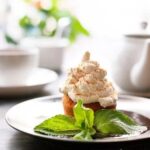Modeling chocolate is a versatile and creative medium that can take your cake decorating skills to the next level. In this article, we will explore how to decorate a cake with modeling chocolate, a technique that allows for intricate designs and personalized touches on your baked creations.
Modeling chocolate offers several benefits over other cake decorating techniques, such as fondant or buttercream. It is easier to work with, provides greater flexibility in shaping intricate details, and has a smooth finish that resembles real chocolate. Whether you are a beginner or an experienced baker, modeling chocolate can add a professional touch to your cakes.
To get started with decorating a cake using modeling chocolate, you will need some basic supplies such as high-quality chocolate and corn syrup. Making modeling chocolate from scratch is simpler than it may seem, and our step-by-step guide will walk you through the process. Additionally, we will explore tips and techniques for coloring modeling chocolate to achieve the desired shades for your designs.
Benefits of Using Modeling Chocolate Over Other Cake Decorating Techniques
Modeling chocolate offers a wide range of benefits that make it a popular choice among cake decorators. One of the key advantages of using modeling chocolate over other cake decorating techniques is its versatility. Unlike fondant, which can often crack or dry out quickly, modeling chocolate is more pliable and easy to work with, allowing for intricate designs and details to be easily created.
Another benefit of using modeling chocolate is its taste. While fondant is often criticized for its overly sweet flavor, modeling chocolate has a rich, creamy taste that pairs well with a variety of cake flavors. This not only enhances the overall taste of the cake but also provides an enjoyable eating experience for those enjoying the finished product.
Additionally, modeling chocolate has a longer shelf life compared to other decorating mediums, making it a more durable option for creating decorations in advance. This allows decorators to plan ahead and create elaborate designs without worrying about their creations drying out or becoming brittle. With proper storage techniques, modeling chocolate decorations can last for weeks, ensuring that cakes look fresh and beautiful until they are ready to be served.
Step-by-Step Guide on How to Decorate a Cake With Modeling Chocolate
Before beginning the process of decorating a cake with modeling chocolate, ensure that you have all the necessary supplies such as modeling chocolate in desired colors, rolling pin, smoothing tool, sharp knife, and cornstarch for dusting surfaces to prevent sticking. Start by preparing your cake with a layer of buttercream frosting as this will help the modeling chocolate adhere smoothly.
Next, roll out your colored modeling chocolate into thin sheets and carefully cover your frosted cake with the sheets like you would with fondant. Use your hands or smoothing tool to gently press the seams together and smooth out any wrinkles or air bubbles. Trim off any excess at the base of the cake with a sharp knife for a clean finish.
Once your cake is covered in modeling chocolate, let your creativity shine by sculpting figures, flowers, or other decorations directly onto the cake surface. For intricate designs like lace patterns or ruffles, use silicone molds or shaping tools to achieve detailed textures. Remember to work quickly as modeling chocolate can harden faster than fondant when exposed to warm temperatures. With practice and patience, you can create stunning works of art on your cakes using modeling chocolate.
Basic Supplies Needed to Work With Modeling Chocolate
Using modeling chocolate to decorate cakes offers a unique and versatile way to express creativity in cake design. Before delving into the actual decorating process, it is essential to gather all the necessary supplies needed to work with modeling chocolate. One of the basic supplies required is high-quality chocolate, preferably dark or white, as it will be used as the base for making the modeling chocolate.
In addition to chocolate, you will need light corn syrup, which acts as a binding agent for the chocolate. This ingredient helps give the modeling chocolate its smooth and pliable texture, making it easier to mold and shape according to your design. Another crucial supply is a microwave-safe bowl or double boiler for melting the chocolate.
Lastly, ensure you have a clean work surface, such as a non-stick silicone mat or parchment paper, to prevent the modeling chocolate from sticking while you are working with it. These basic supplies are essential in setting a solid foundation for creating beautifully decorated cakes using modeling chocolate.
Basic Supplies Needed to Work With Modeling Chocolate
| Supplies | Description |
|---|---|
| High-quality Chocolate | Main ingredient for making modeling chocolate |
| Light Corn Syrup | Binding agent for creating smooth texture |
| Microwave-Safe Bowl or Double Boiler | For melting chocolate properly |
| Clean Work Surface (Silicone Mat or Parchment Paper) | To prevent sticking while shaping modeling chocolate |
Step-by-Step Guide on How to Make Modeling Chocolate From Scratch
Modeling chocolate, also known as chocolate clay or candy clay, is a versatile and fun medium to work with when decorating cakes. It allows for intricate designs, sculpting, and even painting on cakes. Making modeling chocolate from scratch is actually quite simple and only requires a few basic ingredients.
To make modeling chocolate from scratch, you will need high-quality chocolate (either dark, milk, or white), light corn syrup, and a microwave-safe bowl. Start by melting your desired chocolate in the microwave in short intervals, stirring in between until smooth. Once melted, allow the chocolate to cool slightly.
Next, pour in light corn syrup into the melted chocolate and stir until it starts to come together in a dough-like consistency. You may need to knead the mixture with your hands to fully incorporate the corn syrup. If the mixture is too sticky, you can add more melted chocolate or powdered sugar to adjust the consistency.
Once your modeling chocolate is ready, wrap it tightly in plastic wrap and let it rest at room temperature for at least an hour before using it to decorate your cake. This will allow the texture to firm up slightly for easier handling. Now that you know how to make modeling chocolate from scratch, you can unleash your creativity and start decorating beautiful cakes with this versatile medium.
Tips and Techniques for Coloring Modeling Chocolate
Choosing the Right Color
When it comes to coloring modeling chocolate, there are a few options available. You can either use gel or powder food coloring specifically designed for chocolate, or you can use oil-based candy colors.
It is essential to avoid using water-based food coloring as it can cause the chocolate to seize and become unusable. When choosing your colors, remember that a little goes a long way, so start with a small amount and gradually add more until you achieve the desired shade.
Mixing the Coloring
To color your modeling chocolate, start by melting your chocolate according to the recipe. Once melted and cooled slightly, add a small amount of food coloring to the chocolate and gently stir until fully combined.
Remember that modeling chocolate behaves differently than other types of frosting or icing, so be patient and take your time mixing in the color evenly. If you find that your modeling chocolate becomes too sticky or greasy after adding the color, simply knead in some cornstarch until it reaches the right consistency.
Creative Color Combinations
Experimenting with different color combinations can elevate your cake decorating creations to the next level. You can mix various colors together to create new shades or even marble different colors for a beautiful swirled effect.
Adding metallic luster dust or edible glitter to your colored modeling chocolate can also add a touch of glamour and sophistication to your designs. Don’t be afraid to get creative and play around with different hues and finishes to discover unique ways to make your cakes stand out.
By mastering the art of coloring modeling chocolate, you open up endless possibilities for creating stunning and personalized cake decorations that will impress any guest or recipient. So next time you set out to decorate a cake with modeling chocolate, don’t forget these tips and techniques for achieving vibrant and eye-catching colors that will undoubtedly make your creations unforgettable.
How to Properly Cover a Cake With Modeling Chocolate
Modeling chocolate is a fantastic medium for cake decorating due to its versatility and ease of use. One of the key skills to master when working with modeling chocolate is properly covering a cake with this delectable material. Whether you are a beginner or a seasoned baker, mastering the art of covering a cake with modeling chocolate can take your creations to the next level.
To cover a cake with modeling chocolate, you will need to start by preparing your cake. Make sure that your cake is leveled and chilled before you begin the decorating process. This will ensure that the modeling chocolate adheres smoothly to the surface of the cake without any bumps or imperfections.
Next, roll out your modeling chocolate into a thin layer using a rolling pin. Carefully drape the modeling chocolate over the chilled cake and smooth it over the surface using gentle, even strokes with your hands. Trim off any excess edges and use a fondant smoother to ensure that the modeling chocolate adheres seamlessly to the sides of the cake. With practice, you will be able to achieve a flawless finish on your cakes every time.
| Basic Supplies Needed | Step-by-Step Guide |
|---|---|
| Modeling Chocolate | Prepare chilled and leveled cake |
| Rolling Pin | Roll out modeling chocolate into thin layer |
| Fondant Smoother | Smooth over surface evenly |
Covering a cake with modeling chocolate can be both fun and rewarding once you get the hang of it. Experiment with different colors, textures, and designs to create stunning works of edible art that will impress your friends and family. With practice and patience, you can elevate your cake decorating skills to new heights by mastering the art of working with modeling chocolate in this way.
Advanced Decorating Techniques
Modeling chocolate is a fantastic medium for creating intricate and detailed decorations for cakes. One of the most exciting aspects of working with modeling chocolate is the ability to sculpt figurines, flowers, and other decorations with ease. Whether you’re looking to create a whimsical character for a child’s birthday cake or delicate flowers for a wedding dessert, modeling chocolate can help bring your ideas to life.
When it comes to sculpting figures with modeling chocolate, the possibilities are endless. To begin, it’s essential to have a clear image in mind of what you want to create. Start by shaping the body of your figure using small portions of modeling chocolate, gradually adding details like facial features and clothing as you go along. Remember that modeling chocolate is very forgiving, so if you make a mistake, simply smooth it out and start again.
For creating flowers with modeling chocolate, it’s helpful to have some basic tools on hand such as flower cutters, veining tools, and a foam pad for shaping petals. Start by coloring your modeling chocolate in desired shades, then roll it out thinly and cut out petal shapes using the cutters.
Use the veining tool to add texture and dimension to each petal before assembling them into a beautiful flower. Experimenting with different sizes and shapes of petals can result in stunning floral arrangements atop your cakes.
Troubleshooting Common Issues When Working With Modeling Chocolate
Working with modeling chocolate can be a fun and rewarding way to decorate a cake, but like any skill, it can come with its challenges. Fortunately, many common issues that arise when working with modeling chocolate can be easily fixed with a few simple tips and techniques. Here are some troubleshooting suggestions to help you overcome these obstacles and create beautiful cake decorations:
- Cracks in Modeling Chocolate:
- Modeling Chocolate Is Too Sticky:
On the other hand, if your modeling chocolate is too sticky and difficult to work with, try chilling it in the refrigerator for a few minutes to firm it up. You can also dust your hands and work surface with powdered sugar or cornstarch to prevent sticking while shaping the chocolate. - Color Fading or Bleeding:
When coloring modeling chocolate, be aware that certain food coloring gels can cause the colors to fade or bleed over time. To prevent this issue, use oil-based food coloring specifically designed for use with chocolate. You can also let colored modeling chocolate rest for a few hours before using it to allow the color to develop fully.
If you find that your modeling chocolate is cracking as you work with it, this could be due to it being too dry. To fix this issue, try kneading in a small amount of vegetable shortening or corn syrup to add moisture back into the chocolate. Make sure not to overwork the chocolate, as this can also lead to cracking.
With these troubleshooting tips in mind, you’ll be better equipped to handle any potential issues that may arise when working with modeling chocolate. Remember that practice makes perfect, so don’t get discouraged if things don’t go smoothly at first. Experimenting with different techniques and designs will help you improve your skills and create stunning cake decorations.
Ultimately, learning how to decorate a cake with modeling chocolate is a fun and creative process that allows you to express your artistic flair. Don’t be afraid to try new ideas and push yourself out of your comfort zone – you may just discover a newfound passion for cake decorating.
Inspiring Cake Decorating Ideas Using Modeling Chocolate
Modeling chocolate offers endless possibilities when it comes to decorating cakes. Here are some inspiring ideas to help you unleash your creativity and elevate your cake decorating game using this versatile and delicious medium:
- Create a whimsical garden-themed cake by sculpting delicate flowers, leaves, and butterflies out of modeling chocolate. Use different colors to add depth and dimension to your edible garden masterpiece.
- Give your cake a touch of elegance by crafting intricate lace patterns using thin strips of white modeling chocolate. This technique adds a sophisticated and romantic flair to any special occasion cake.
- For a playful and fun design, make adorable edible figurines using modeling chocolate. From cute animals to cartoon characters, the only limit is your imagination. These charming figurines are sure to delight both children and adults alike.
Whether you’re celebrating a birthday, anniversary, or any other special event, incorporating modeling chocolate into your cake decorating will surely impress your guests and create memorable moments. Experiment with different shapes, colors, and textures to bring your unique vision to life on your next sweet creation. So grab your tools, get creative with modeling chocolate, and watch as your cakes become true works of art.
Conclusion
Modeling chocolate offers a versatile and creative way to decorate cakes, allowing for endless possibilities to bring your unique designs to life. By following the step-by-step guide on how to make modeling chocolate from scratch and learning tips for coloring and covering a cake with it, you can easily create stunning decorations that will impress your friends and family.
Whether you’re sculpting figures, flowers, or other intricate designs, modeling chocolate provides a smooth and pliable medium to work with, making it an ideal choice for cake decorating.
One of the benefits of using modeling chocolate over other cake decorating techniques is its ease of use and ability to hold intricate shapes without sagging or melting. With just a few basic supplies, you can start experimenting with different styles and techniques to elevate your cakes to the next level. Additionally, by troubleshooting common issues that may arise when working with modeling chocolate, you can ensure a successful decorating experience every time.
In conclusion, I encourage readers to try their hand at decorating a cake with modeling chocolate and let their creativity shine through. Experiment with colors, shapes, and designs to create one-of-a-kind cakes that will be the centerpiece of any occasion.
With the right techniques and a little practice, you’ll soon discover the endless possibilities that modeling chocolate has to offer in cake decorating. So go ahead, unleash your imagination, and enjoy the process of creating edible masterpieces that will delight everyone who sees them.
Frequently Asked Questions
How Do You Get Modeling Chocolate to Stick to a Cake?
To get modeling chocolate to stick to a cake, you can use a thin layer of buttercream or apricot glaze on the surface of the cake before applying the modeling chocolate. Press the chocolate gently onto the cake to ensure it adheres properly.
Can You Cover a Cake With Modelling Chocolate?
Yes, you can cover a cake with modeling chocolate. Roll out the modeling chocolate into a thin sheet using a rolling pin and then carefully drape it over the cake. Smooth out any wrinkles or air bubbles using your hands or a smoother tool.
Will Modeling Chocolate Harden?
Modeling chocolate will harden to some extent after being left at room temperature for some time. However, it will remain pliable enough to work with and mold for quite some time before becoming completely rigid. Store any leftover modeling chocolate in an airtight container to maintain its texture.

Welcome to my blog about home and family. This blog is a place where I will share my thoughts, ideas, and experiences related to these important topics. I am a stay-at-home mom with two young children. I hope you enjoy reading it! and may find some helpful tips and ideas that will make your home and family life even better!





